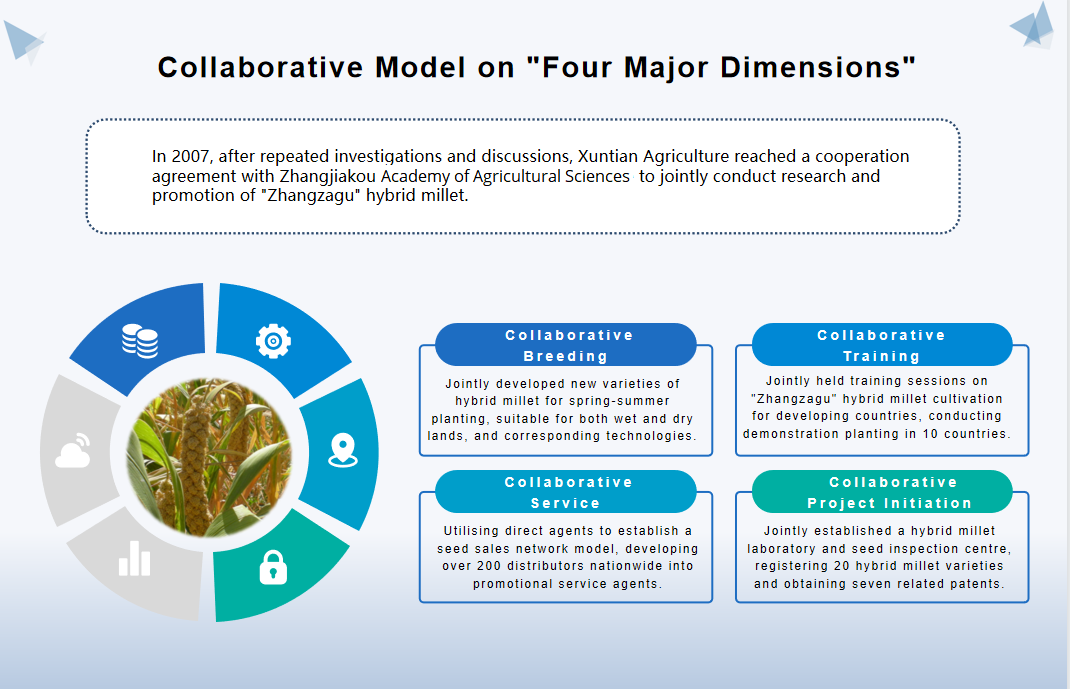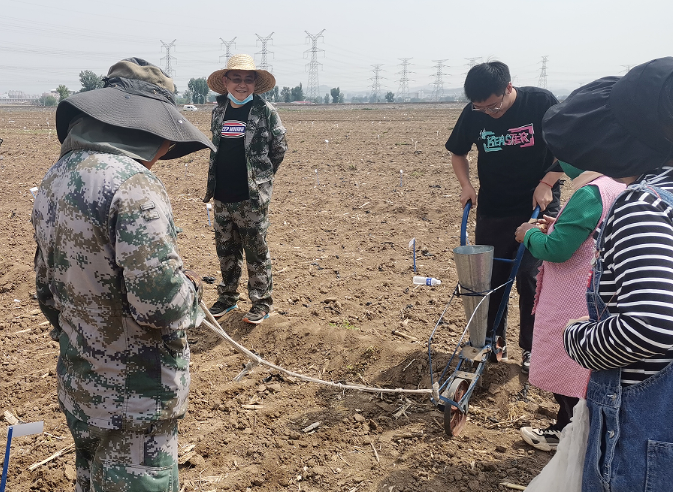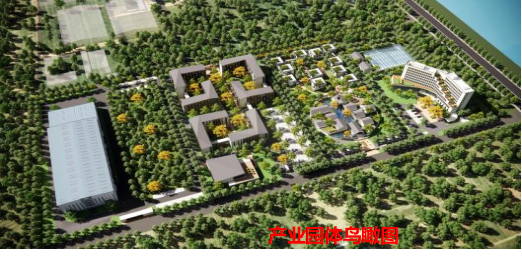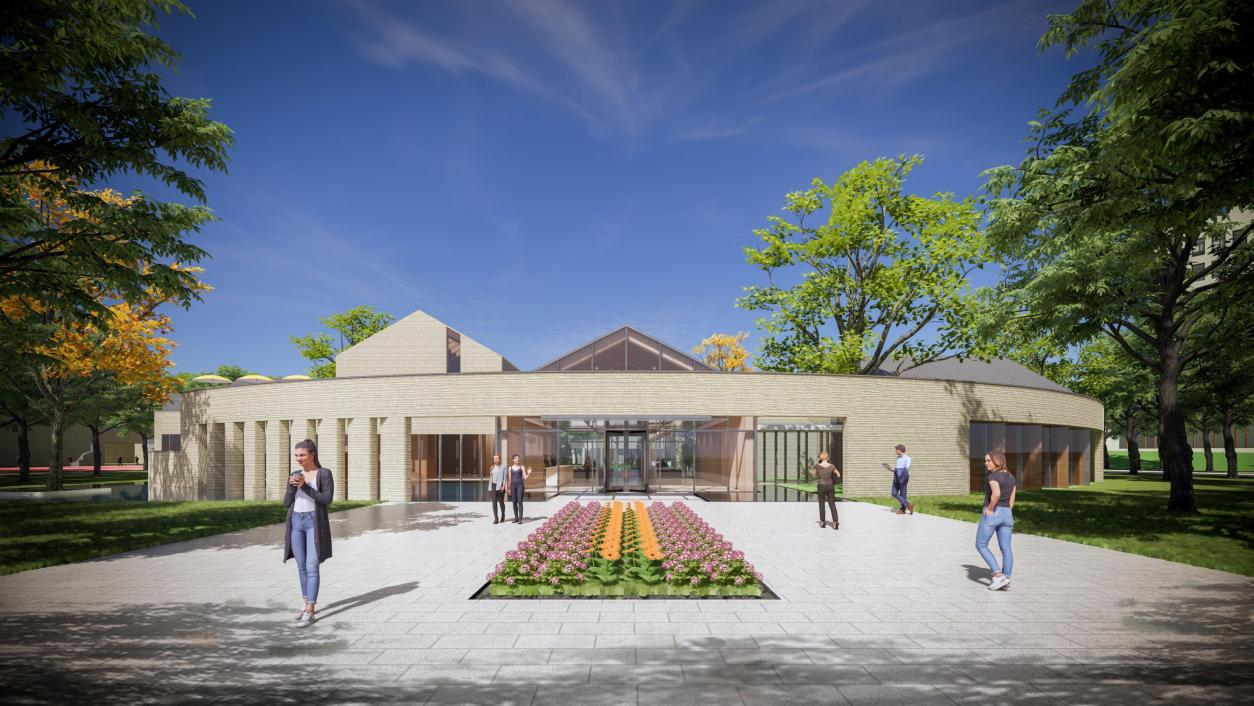I. Project Overview
The "Zhangzagu" hybrid millet boasts high yield and quality, drought resistance, and water-saving properties. In semi-arid areas, its average yield per acre can range from 400kg to 600kg, which is over 100kg higher than that of traditional dryland grain crops. However, around 2007, due to a lower consumption rate of millet in China and immature production, processing, and sales chains, it was challenging to persuade farmers accustomed to growing staple crops like maize and wheat in China's dry and semi-dry areas to switch to hybrid millet.
Ⅱ. Approaches and Methodology
To promote the large-scale cultivation of hybrid millet and establish a complete millet value chain, any concerns farmers had about planting hybrid millet had to be completely dispelled. In 2007, the Zhangjiakou Academy of Agricultural Sciences reached a cooperation agreement with Hebei Xuntian Agricultural Technology Co., Ltd. (hereafter referred to as Xuntian Agriculture) to jointly conduct research and promotion of "Zhangzagu" hybrid millet. To further complement the advantages of scientific research technology and effective market promotion, in 2012, Zhangjiakou Academy of Agricultural Sciences became the second-largest shareholder of Xuntian Agriculture by contributing the intellectual property rights of hybrid millet.

1) In the production and R&D stage, Zhangjiakou Academy of Agricultural Sciences deeply studied comprehensive cultivation techniques for "Zhangzagu" hybrid millet and conducted farmer technical training, developing technical training materials and systems.
2) In the promotion stage, Xuntian Agriculture developed over 200 distributors nationwide into agents for technology and service promotion, organised variety observation meetings, and provided farmers with comprehensive free technical guidance from planting to harvest, building their confidence. They also set up WeChat groups to promptly provide farmers with technical measures to address weather disasters and pests, ensuring yields.
3) In the sales stage, during the annual procurement season in August, they organised grain merchant coordination meetings to harmonise the procurement regions of major grain merchants, avoiding the issue where farmers experience "increased production but not increased income". To address the sales challenges of large-scale promotion, they targeted the domestic fodder market's long-term shortage, advancing the strategy of "storing grain in livestock", transforming "Zhangzagu" hybrid millet into fodder, and converting millet grains into meat, eggs, and milk, effectively addressing the issue of low added value when selling millet as raw grain.
This deep cooperation not only strengthened the interest ties between research institutes, enterprises, agents, and farmers but also accelerated the promotion of hybrid millet. Additionally, both parties jointly built the World Millet Culture Centre to enhance the "Zhangzagu" brand, ensuring quality millet fetched good prices.

Expert Fan Guangyu (second from left) of Zhangjiakou Academy of Agricultural Sciences guiding millet test planting.

The National Modern Agricultural Industrial Park in Xuanhua District, Zhangjiakou City, was approved for establishment by the Ministry of Agriculture and Rural Affairs and the Ministry of Finance in April 2020. It took "Zhangzagu" as the leading industry to create a comprehensive industrial demonstration zone.

Conceptual image of the World Millet Culture Centre, promoting and enhancing the cultural significance of the "Zhangzagu" brand.
The National Modern Agricultural Industrial Park in Xuanhua District, Zhangjiakou City, was approved for establishment by the Ministry of Agriculture and Rural Affairs and the Ministry of Finance in April 2020. It took "Zhangzagu" as the leading industry to create a comprehensive industrial demonstration zone.
Conceptual image of the World Millet Culture Centre, promoting and enhancing the cultural significance of the "Zhangzagu" brand.
III. Project Outcomes and Output
The Zhangjiakou Academy of Agricultural Sciences developed various training materials for "Zhangzagu" hybrid millet, such as mulch sowing technology, key period management technology, disease and pest control technology, anti-lodging cultivation technology, weed control technology, and cutting and sun-drying harvest technology. They organised demonstration meetings for new varieties of "Zhangzagu", new type sowing machines, and "Zhangzagu" harvesting, serving over 20,000 farmers.
As of 2022, hybrid millet had been promoted across 14 provinces and regions in China, covering more than 2.66 million hectares, saving 8 billion cubic meters of water, and increasing income by 80 billion yuan. In recent years, the promotion area has consistently exceeded 200,000 hectares, making it the most widely promoted millet variety in China. In drylands along the Great Wall with 400mm of annual rainfall, every 2.66 million hectaresyields 300 to 500kg, with the highest yield reaching 843kg, achieving significant social, economic, and ecological benefits.
Furthermore, the advantages of hybrid millet were quickly recognised by developing countries in Africa. To date, Xuntian Agriculture and Zhangjiakou Academy of Agricultural Sciences have jointly held 14 training sessions on "Zhangzagu" hybrid millet cultivation for 21 developing countries, serving over 200 attendees. Hybrid millet, as a key project in South-South Cooperation, has been demonstration planted in 10 African countries including Ethiopia, Uganda, and Nigeria, becoming a top-choice project for China's agricultural "going global" initiative.

For more information, please contact WFP China COE (wfpcn.coe@wfp.org)
Category
Effectively Expanding the Value Chain of "Zhangzagu" Hybrid Millet
Contributor
Effectively Expanding the Value Chain of "Zhangzagu" Hybrid Millet
Country
Case Study

